Spectrum Summary: Constitutional, Administrative & Judicial Developments | History for UPSC CSE PDF Download
Introduction
- The establishment of the East India Company in 1600 and its transformation into a ruling body from a trading one in 1765 had little immediate impact on Indian polity and governance.
- But the period between 1773 and 1858 under the Company rule, and then under the British Crown till 1947, witnessed a plethora of constitutional and administrative changes.
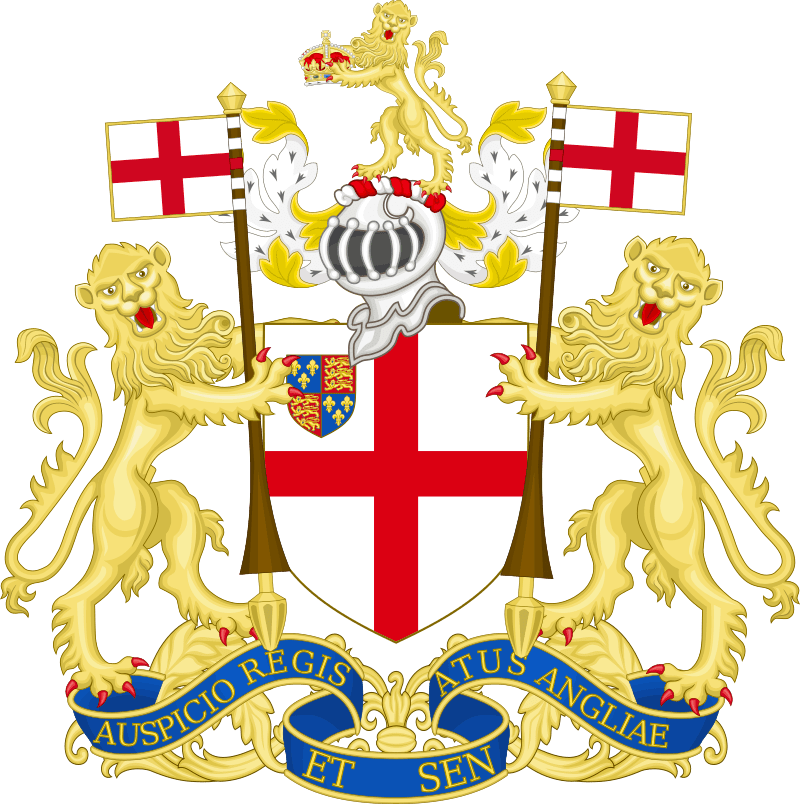 Coat of arms of the East India Company
Coat of arms of the East India Company - The nature and objective of these changes were to serve the British imperial ideology but unintentionally they introduced elements of the modern State into India’s political and administrative system.
Constitutional Development between 1773 and 1858
After the Battle of Buxar (1764), the East India Company got the Diwani (right to collect revenue) of Bengal, Bihar, and Orissa. 1767- The first intervention in Indian affairs by the British government came in 1767. 1765-72- This period was characterized by(i) Rampant corruption among servants of the Company who made full use of private trading to enrich themselves;(ii) Excessive revenue collection and oppression of peasantry;(iii) Company’s bankruptcy, while the servants were flourishing.
The Regulating Act of 1773
The Regulating Act of 1773 (formally, the East India Company Act 1772) was an Act of the Parliament of Great Britain intended to overhaul the management of the East India Company's rule in India.

- British government’s involvement in Indian affairs in the effort to control and regulate the functioning of the East India Company. It recognized that the Company’s role in India extended beyond mere trade to administrative and political fields, and introduced the element of centralized administration.
- Directors of the Company were required to submit all correspondence regarding revenue affairs and civil and military administration to the government.
- In Bengal, the administration was to be carried out by the governor-general and a council consisting of 4 members, representing the civil and military government. They were required to function according to the majority rule.
- A Supreme Court of judicature was to be established in Bengal with original and appellate jurisdictions where all subjects could seek redressal. In practice, however, the Supreme Court had a debatable jurisdiction vis-a-vis the council which created various problems.
- Governor-general could exercise some powers over Bombay and Madras—again, a vague provision which created many problems
Amendments (1781)
 (i) Jurisdiction of the Supreme Court was defined—within Calcutta, it was to administer the personal law of the defendant.
(i) Jurisdiction of the Supreme Court was defined—within Calcutta, it was to administer the personal law of the defendant.
(ii) Servants of the government were immune if they did anything while discharging their duties.
(iii) Social and religious usages of the subjects were to be honoured.
Pitt’s India Act of 1784
The Pitt's India Act of 1784, was an Act of the Parliament of Great Britain intended to address the shortcomings of the Regulating Act of 1773 by bringing the East India Company's rule in India under the control of the British Government.
- The company became a subordinate department of the State. The Company’s territories in India were termed British possessions’.
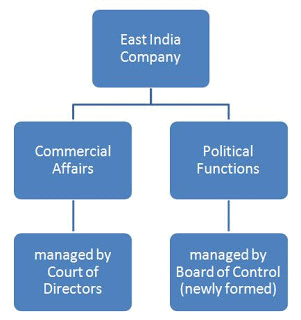 Provisions - Pitt's India Act 1784
Provisions - Pitt's India Act 1784
- A Board of Control consisting of the chancellor of the exchequer, a secretary of state and four members of the Privy Council (to be appointed by the Crown) were to exercise control over the Company’s civil, military, and revenue affairs. All dispatches were to be approved by the board. Thus a dual system of control was set up.
- In India, the governor-general was to have a council of three (including the commander-in-chief), and the presidencies of Bombay and Madras were made subordinate to the governor-general.
- A general prohibition was placed on aggressive wars and treaties (breached often).
The Act of 1786
In 1786 Pitt brought another bill in the Parliament relating to India in a bid to prevail upon Cornwallis to accept the Governor Generalship of India.
- Cornwallis wanted to have the powers of both the governor-general and the commander-in-chief. The new Act conceded this demand and also gave him power.
- Cornwallis was allowed to override the council’s decision if he owned the responsibility for the decision. Later, this provision was extended to all the governors-general.
The Charter Act of 1793
The Charter Act of 1793, also known as the East India Company Act 1793 was passed in the British Parliament in which the company charter was renewed.
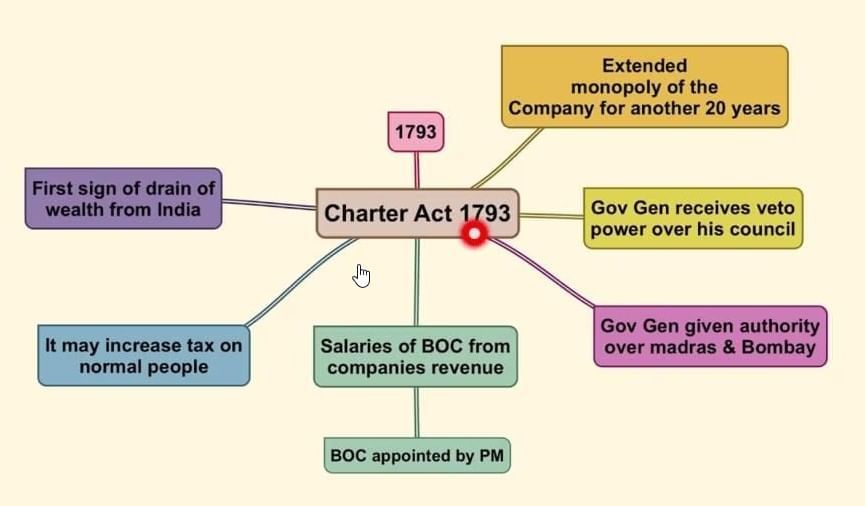
- The Act renewed the Company’s commercial privileges for the next 20 years.
- The Company, after paying the necessary expenses, interest, dividends, salaries, etc., from the Indian revenues, was to pay 5 lakh pounds annually to the British government.
- The royal approval was mandated for the appointment of the governor-general, the governors, and the commander-in-chief.
- Senior officials of the Company were debarred from leaving India without permission—doing so was treated as a resignation.
- The Company was empowered to give licenses to individuals as well as the Company’s employees to trade in India. The licenses, known as 'privilege’ or 'country trade', paved the way for shipments of opium to China.
- The revenue administration was separated from the judiciary functions and this led to the disappearance of the Maal Adalats.
- The Home Government members were to be paid out of Indian revenues which continued up to 1919.
The Charter Act of 1813
The Charter Act of 1813 passed by the British Parliament renewed the East India Company’s charter for another 20 years.This act is important in that it defined for the first time the constitutional position of British Indian territories.
- The Company’s monopoly over trade in India ended, but the Company retained the trade with China and the trade-in tea.
- The Company’s shareholders were given a 10.5 percent dividend on the revenue of India. The Company was to retain the possession of territories and the revenue for 20 years more, without prejudice to the sovereignty of the Crown.
- Powers of the Board of Control were further enlarged.
- A sum of one lakh rupees was to be set aside for the revival, promotion, and encouragement of literature, learning, and science among the natives of India, every year.
- The regulations made by the Councils of Madras, Bombay, and Calcutta were now required to be laid before the British Parliament. The constitutional position of the British territories in India was thus explicitly defined for the first time.
- Separate accounts were to be kept regarding commercial transactions and territorial revenues. The power of superintendence and direction of the Board of Control was not only defined but also enlarged considerably.
- Christian missionaries were also permitted to come to India and preach their religion.
The Charter Act of 1833
The lease of 20 years to the Company was further extended in the Charter Act of 1833. Territories of India were to be governed in the name of the Crown.
- The company’s monopoly over trade with China and in tea also ended.
- All restrictions on European immigration and the acquisition of property in India were lifted.
- In India, a financial, legislative, and administrative centralization of the government was envisaged:
(i) Governor-general was given the power to superintend, control, and direct all civil and military affairs of the Company.
(ii) Bengal, Madras, Bombay, and all other territories were placed under complete control of the governor-general.
(iii) All revenues were to be raised under the authority of the governor-general who would have complete control over the expenditure too.(iv) Governments of Madras and Bombay were drastically deprived of their legislative powers and left with a right of proposing to the governor-general the projects of law which they thought to be expedient. - A law member was added to the governor-general’s council for professional advice on lawmaking. vi. Indian laws were to be codified and consolidated. No Indian citizen was to be denied employment under the Company on the basis of religion, color, birth, descent, etc
- The administration was urged to take steps to ameliorate the conditions of slaves and to ultimately abolish slavery. (Slavery was abolished in 1843.)
The Charter Act of 1853
The Charter Act 1853 was passed in the British Parliament to renew the East India Company’s charter. Unlike the previous charter acts of 1793, 1813 and 1833 which renewed the charter for 20 years; this act did not mention the time period for which the company charter was being renewed.

- The company was to continue possession of territories unless the Parliament provided otherwise.
- The strength of the Court of Directors was reduced to 18.
- The company’s patronage over the services was dissolved—the services were now thrown open to a competitive examination.
- Law member became the full member of the governor-general’s executive council.
- separation of the executive and legislative functions of the Government of British India progressed with the inclusion of six additional members for legislative purposes
The Act for Better Government of India, 1858
The Government of India Act 1858 was an Act of the British parliament that transferred the government and territories of the East India Company to the British Crown.
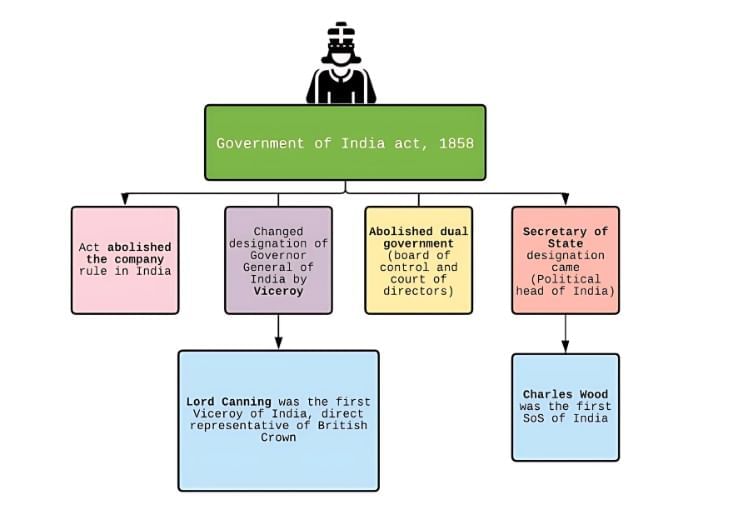
- The company’s rule over British territories in India came to an end and it was passed directly to the British government.
- India was to be governed by and in the name of the Crown through a secretary of state and a council of 15. The initiative and the final decision was to be with the secretary of state and the council was to be just advisory in nature.
- Governor-general became the viceroy
Developments after 1858 till Independence
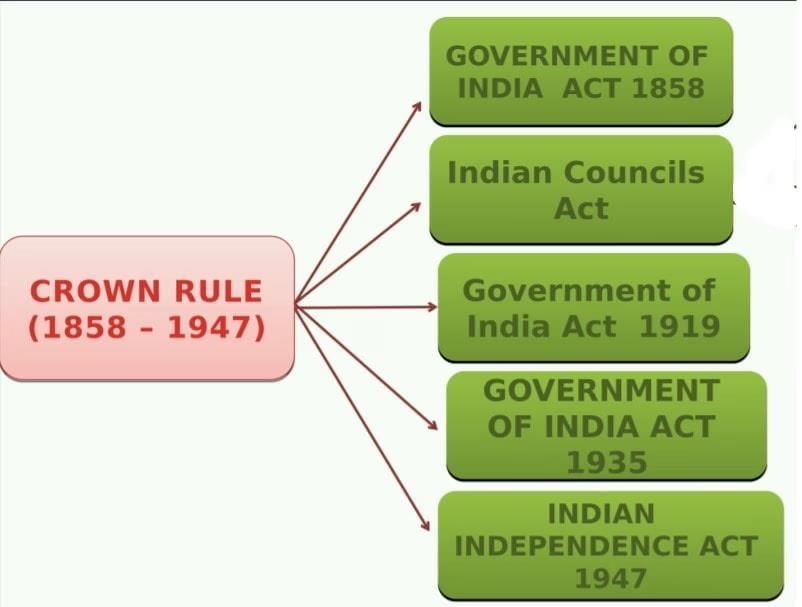
Indian Councils Act, 1861
The Indian Councils Act 1861 was an act of the British Parliament that made significant changes in the Governor-General’s Council.

- The 1861 Act marked an advance in that the principle of representatives of nonofficials in legislative bodies became accepted; laws were to be made after due deliberation, and as pieces of legislation they could be changed only by the same deliberative process.
- The portfolio system introduced by Lord Canning laid the foundations of cabinet government in India, each branch of the administration having its official head and spokesman in the government, who was responsible for its administration.
- The Act by vesting legislative powers in the Governments of Bombay and Madras and by making provision for the institution of similar legislative councils in other provinces laid the foundations of legislative devolution.
Indian Councils Act, 1892
The Indian Councils Act 1892 was an act of the British Parliament that increased the size of the legislative councils in India.
- In 1885, the Indian National Congress was founded. Congress saw the reform of the councils as the “'root of all other reforms ’. It was in response to the Congress's demand that the legislative councils be expanded that the number of non-official members was increased both in the central (Imperial) and provincial legislative councils by the Indian Councils Act, 1892.
- Legislative Council of the Governor-General was enlarged.
- Universities, district boards, municipalities, zamindars, trade bodies, and chambers of commerce were empowered to recommend members to the provincial councils.
- Thus was introduced the principle of representation.
- Though the term election' was firmly avoided in the Act, an element of the indirect election was accepted in the selection of some of the non-official members.
- Members of the legislatures were now entitled to express their views upon financial statements which were henceforth to be made on the floor of the legislatures.
- Could also put questions within certain limits to the executive on matters of public interest after giving six days’ notice.
Indian Councils Act, 1909
The Indian Councils Act 1909 was an act of the British Parliament that introduced a few reforms in the legislative councils and increased the involvement of Indians (limited) in the governance of British India.
- Popularly known as the Morley-Minto Reforms, the Act made the first attempt to bring in a representative and popular element in the governance of the country.
- The strength of the Imperial Legislative Council was increased.
- With regard to the central government, an Indian member was taken for the first time in the Executive Council of the Governor-General
- Members of the Provincial Executive Council were increased.
- Powers of the legislative councils, both central and provincial, were increased.
Government of India Act, 1919
The Government of India Act 1919 was an act of the British Parliament that sought to increase the participation of Indians in the administration of their country.
- This Act was based on what is popularly known as the Montague-Chelmsford Reforms.
- Under the 1919 Act, the Indian Legislative Council at the Centre was replaced by a bicameral system consisting of a Council of State (Upper House) and a Legislative Assembly (Lower House). Each house was to have a majority of members who were directly elected. So, the direct election was introduced, though the franchise was much restricted being based on qualifications of property, tax, or education.
- The principle of communal representation was extended with separate electorates for Sikhs, Christians, and Anglo-Indians, besides Muslims.
- The act introduced dyarchy in the provinces, which indeed was a substantial step towards the transfer of power to the Indian people.
- The provincial legislature was to consist of one house only (legislative council).
- Act separated for the first time the provincial and central budgets, with provincial legislatures being authorized to make their budgets.
- A High Commissioner for India was appointed, who was to hold his office in London for six years and whose duty was to look after Indian trade in Europe.
- Secretary of State for India who used to get his pay from the Indian revenue was now to be paid by the British Exchequer, thus undoing an injustice in the Charter Act of 1793.
- Though Indian leaders for the first time got some administrative experience in a constitutional set-up under this Act.
Simon Commission
The Indian Statutory Commission also known as Simon Commison’, was a group of seven Members of Parliament under the chairmanship of Sir John Simon (later, 1st Viscount Simon).
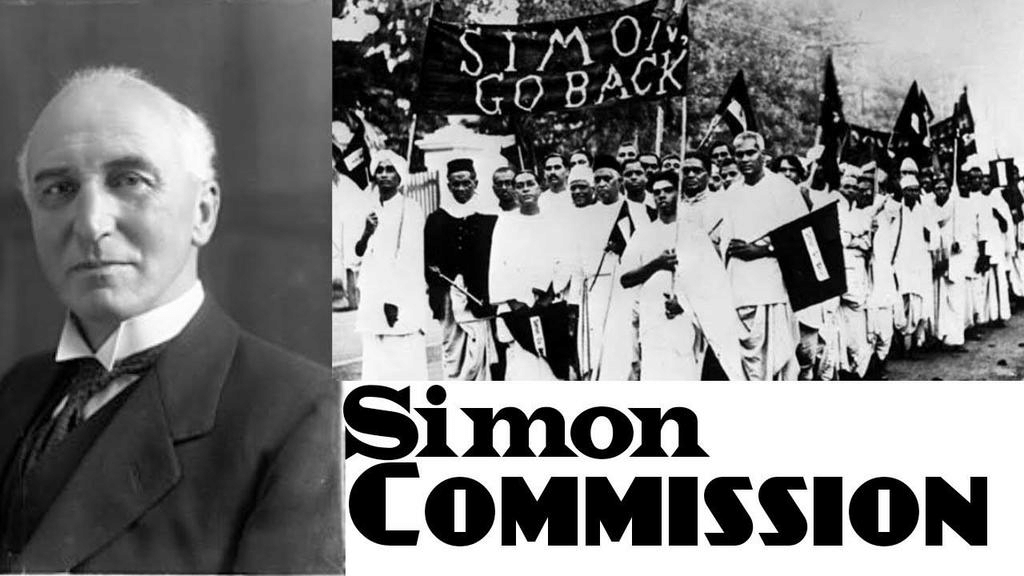
- The commission arrived in British India in 1928 to study constitutional reform in Britain’s largest and most important possession.
- 1919 Act had provided that a Royal Commission would be appointed ten years after the Act to report on its working. Three Round Table Conferences were called by the British government to consider the proposals.
- Subsequently, a White Paper on Constitutional Reforms was published by the British government in March 1933
Government of India Act, 1935
The Government of India Act was passed by the British Parliament in August 1935. It was the longest act enacted by the British Parliament at that time. So, it was divided into two separate acts namely, the Government of India Act 1935 and the Government of Burma Act 1935.
- Act, with 451 clauses and 15 schedules, contemplated the establishment of an All- India Federation in which Governors’ Provinces and the Chief Commissioners’ Provinces and those Indian states which might accede to be united were to be included.
- Dyarchy, rejected by the Simon Commission, was provided for in the Federal Executive.
- Federal Legislature was to have two chambers (bicameral)—the Council of States and the Federal Legislative Assembly. The Council of States (the Upper House) was to be a permanent body.
- There was a provision for joint sitting in cases of deadlock between the houses. There were to be three subject lists— the Federal Legislative List, the Provincial Legislative List and the Concurrent Legislative List. Residuary, legislative powers were subject to the discretion of the governor-general.
- Dyarchy in the provinces was abolished and provinces were given autonomy
- Provincial legislatures were further expanded. Bicameral legislatures were provided in the six provinces of Madras, Bombay, Bengal, United Provinces, Bihar and Assam, with other five provinces retaining unicameral legislatures.
- Principles of'communal electorates’ and 'weightage' were further extended to depressed classes, women and labour.
- Franchise was extended, with about 10 per cent of the total population getting the right to vote.
- Act also provided for a Federal Court (which was established in 1937), with original and appellate powers, to interpret the 1935 Act and settle inter-state disputes, but the Privy Council in London was to dominate this court. India Council of the Secretary of State was abolished.
- All-India Federation as visualised in the Act never came into being because of the opposition from different parties of India. The British government decided to introduce the provincial autonomy on April 1,1937, but the Central government continued to be governed in accordance with the 1919 Act, with minor amendments. The operative part of the Act of 1935 remained in force till August 15, 1947.
Evolution of Civil Services in India
Cornwallis’ Role
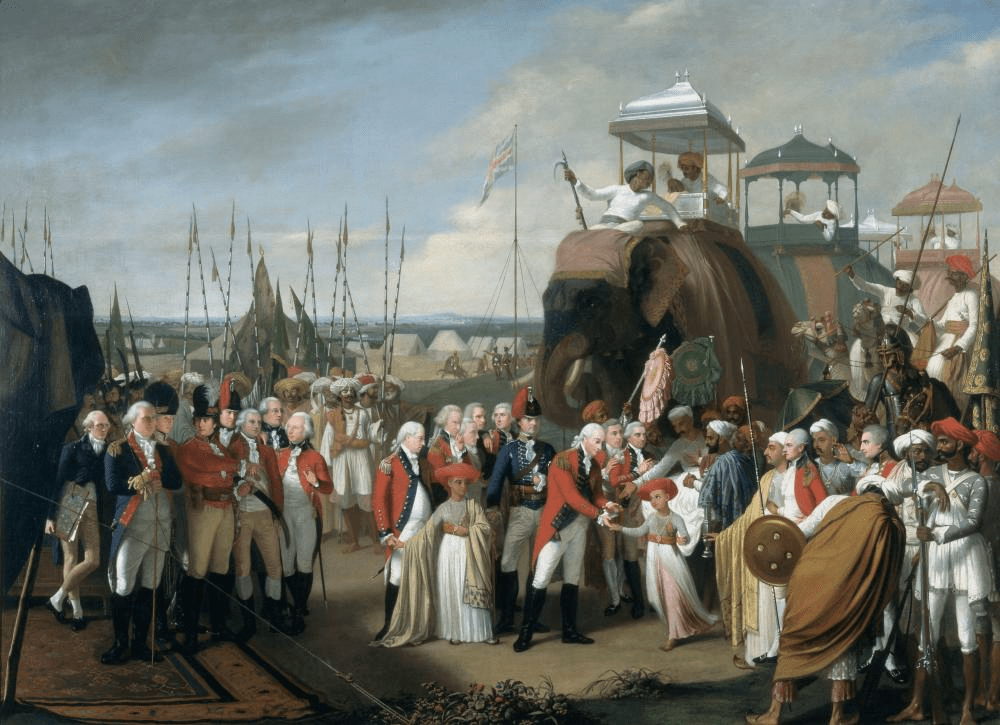 Lord Cornwallis in India
Lord Cornwallis in India
- Cornwallis (governor-general, 1786-93) was the first to bring into existence and organize civil services. He tried to check corruption through
- Raising the civil servants’ salary,
- Strict enforcement of rules against private trade,
- Debarring civil servants from taking presents, bribes, etc.,
- Enforcing promotions through seniority.
Wellesley’s Role
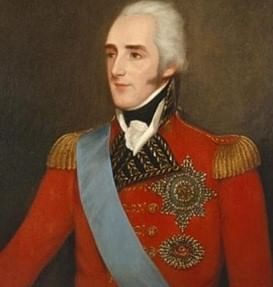 Lord Wellesley
Lord Wellesley
- Wellesley (governor-general, 1798-1805) set up Fort William College for the training of new recruits. In 1806 Wellesley’s college was disapproved by the Court of Directors and instead the East India College was set up at Haileybury in England to impart two years’ training to the recruits.
Charter Act of 1853
The reasons for the exclusion of Indians were
(i) Belief that only the English could establish administrative services serving British interests;
(ii) Belief that the Indians were incapable, untrustworthy, and insensitive to the British interests;
(iii) Fact there was high competition among the Europeans themselves for lucrative posts, so why offer them to the Indians.
Indian Civil Service Act, 1861
- The maximum permissible age was gradually reduced from 23 (in 1859) to 22 (in 1860) to 21 (in 1866) and to 19 (1878).
- In 1863, Satyendra Nath Tagore became the first Indian to qualify for the Indian Civil Service.
Statutory Civil Service
- In 1878-79, Lytton introduced the Statutory Civil Service consisting of one-sixth of covenanted posts to be filled by Indians
Congress Demand and Aitchison Committee
- The Indian National Congress raised the demand, after it was set up in 1885, for
(i) lowering of age limit for recruitment, and
(ii) Holding the examination simultaneously in India and Britain. - The Aitchison Committee on Public Services (1886), set up by Dufferin. recommended—
(i)The dropping of the terms covenanted’ and "uncovenanted’;
(ii) Classification of the civil service into Imperial Indian Civil Service (examination in England), Provincial Civil Service (examination in India), and Subordinate Civil Service (examination in India); and, raising the age limit to 23.
(iii) In 1893, the House of Commons in England passed a resolution supporting the holding of simultaneous examination in India and England; but the resolution was never implemented.
Montford Reforms (1919)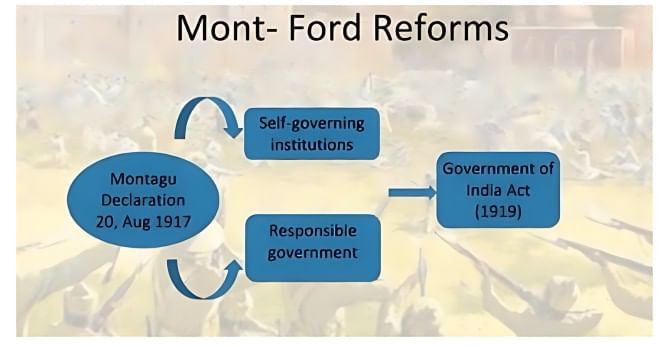
- The Montford reforms— i. Stated a realistic policy recommended holding of simultaneous examination in India and England. ii. recommended that one-third of recruitments be made in India itself—to be raised annually by 1.5 percent.
Lee Commission (1924)
- The Lee Commission recommended that
(i)secretary of state should continue to recruit the ICS, the Irrigation branch of the Service of Engineers, the Indian Forest Service, etc.;
(ii) recruitments for the transferred fields like education and civil medical service be made by provincial governments;
(iii) direct recruitment to ICS on basis of 50:50 parity between the Europeans and the Indians be reached in 15 years;
(iv) a Public Service Commission be immediately established
Government of India Act, 1935
- 1935 Act recommended the establishment of a Federal Public Service Commission and Provincial Public Service Commission under their spheres.
Evaluation of Civil Services under British Rule
- This was done in mainly two ways. Firstly the maximum age for appearing at the examination was reduced from twenty-three in 1859 to nineteen in 1878 under Lytton. Secondly, all key positions of power and authority and those which were well-paid were occupied by the Europeans.
Evolution of Police System in Modern India

- Watch guards since time immemorial protecting villages at night. Under the Mughal rule, there were the faujdars and mails. The kotwal was responsible for the maintenance of law and order in the cities. In Bengal, Bihar, and Orissa between 1765 and 1772 the zamindars were expected to maintain the staff including thanedars In 1775, faujdar thanas were established
- 1791 Cornwallis organized a regular police force to maintain law and order by going back to and modernizing the old Indian system of thanas (circles) in a district under a daroga (an Indian) and a superintendent of police (SP).1808 Mayo appointed an SP for each division helped by a number of spies (goyendas)
- Recommendations of the Police Commission (1860) led to the Indian Police (i)Act, 1861. The commission recommended—
A system of civil constabulary—maintaining the village set-up in the present form (a village watchman maintained by the village) but the indirect relationship with the rest of the constabulary.
(ii) Inspector-general as the head in a province, deputy inspector-general as the head in a range, and SP as the head in a district. - 1902 The Police Commission recommended the establishment of CID
Military Under the British
- Prior to the revolt of 1857, there were two separate sets of military forces under British control, which operated in India. The first set o: I units, known as the Queen's army, were the serving troops on duty in India. The other was the Company's troops—a mixture of European regiments of Britons and Native regiments recruited locally from India but with British officers. The Queen’s army was part of the Crown's military force.
- On the whole, the British Indian Army remained a costly military machine.
Development of Judiciary in British India
- The beginning of a common-law system, based on recorded judicial precedents, can be traced to the establishment of 'Mayor s Courts' in Madras, Bombay, and Calcutta in 1726 by the East India Company.
- Reforms under Warren Hastings (1772-1785)-
(i)District Diwani Adalats were established in districts to try civil disputes. These adults were placed under the collector and had Hindu law applicable for Hindus and the Muslim law for Muslims. The appeal from District Diwani Adalats lay to the Sadar Diwani Adalat which functioned under a president and two members of the Supreme Council.
(ii)District Fauzdari Adalats were set up to try criminal disputes and were placed under an Indian officer assisted by qazis and muftis. These adults also were under the general supervision of the collector. Muslim law was administered in Fauzdari Adalats.
(iii)Under the Regulating Act of 1773, a Supreme Court was established at Calcutta which was competent to try all British subjects within Calcutta and the subordinate factories, including Indians and Europeans. It had original and appellate jurisdictions. Often, the jurisdiction of the Supreme Court clashed with that of other courts.
Reforms under Cornwallis (1786-1793) — Separation of Powers
- Circuit courts were established at Calcutta, Dacca, Murshidabad, and Patna. These circuit courts had European judges and were to act as courts of appeal for both civil and criminal cases.
- Sadar Nizamat Adalat was shifted to Calcutta and was put under the governor-general and members of the Supreme Council assisted by the chief qazi and the chief mufti. The District Diwani Adalat was now designated as the District, City, or the Zila Court and placed under a district judge. The collector was now responsible only for the revenue administration with no magisterial functions.
- A gradation of civil courts was established (for both Hindu and Muslim laws)
(i) Munsiff s Court under Indian officers,
(ii) Registrar’s Court under a European judge,
(iii) District Court under the district judge,
(iv)Four Circuit Courts as provincial courts of appeal,
(v) Sadar Diwani Adalat at Calcutta, and
(vi) King-in-Council for appeals of 5000 pounds and above. - The Cornwallis Code was laid out
(i)There was a separation of revenue and justice administration.
(ii) European subjects were also brought under jurisdiction.
(iii) Government officials were answerable to the civil courts for actions done in their official capacity.
(iv) Principle of the sovereignty of law was established.
Reforms under William Bentinck (1828-1833)
- Four Circuit Courts were abolished and their functions transferred to collectors under the supervision of the commissioner of revenue and circuit.
- Sadar Diwani Adalat and Sadar Nizamat Adalat were set up at Allahabad for the convenience of the people of Upper Provinces.
- Till now, Persian was the official language in courts. Now, the suitor had the option to use Persian or a vernacular language, while in the Supreme Court, the English language replaced Persian.
- 1833:A Law Commission was set up under Macaulay for the codification of Indian laws. As a result, a Civil Procedure Code (1859), an Indian Penal Code (1860), and a Criminal Procedure Code (1861) were prepared.
Later Developments
- 1860: It was provided that the Europeans can claim no special privileges except in criminal cases, and no judge of an Indian origin could try them.
- 1865: Supreme Court and the Sadar Adalats were merged into three High Courts at Calcutta, Bombay, and Madras.
- 1935: The government of India Act provided for a Federal Court (set up in 1937) which could settle disputes between governments and could hear limited appeals from the High Courts.
Evaluation
Positive Aspects of Judiciary under the British
- Rule of law was established.
- Codified laws replaced the religious and personal laws of the rulers.
- Even European subjects were brought under the jurisdiction, although in criminal cases, they could be tried by European judges only.
- Government servants were made answerable to the civil courts.
The Negative Aspects
- The judicial system became more and more complicated and expensive. The rich could manipulate the system.
- There was ample scope for false evidence, deceit, and chicanery.
- Dragged out litigation meant delayed justice.
- Courts became overburdened as litigation increased
- Often, the European judges were not familiar with the Indian usage and traditions.
Major Changes in Administrative Structure after 1857
- The genesis of Administrative Changes: New Stage of Colonialism-There was a renewed upsurge of imperial control and imperialist ideology which was reflected in the reactionary policies during the vice-royalties of Lytton, Dufferin, Lansdowne, Elgin, and, above all, Curzon. The changes in the governmental structure and policies in India were to shape the destiny of modern India in many ways.
Administration: Central, Provincial, Local
Central Government
- Act for Better Government of India, 1858 transferred the power to govern from the East India Company to the British Crown.
- (ii) By the Indian Councils Act, 1861, a fifth member, who was to be a jurist, was added to the viceroy’s executive council. The legislative council so constituted possessed no real powers and was merely advisory in nature. Its weaknesses were as follows:
- It could not discuss important matters and no financial matters at all without the previous approval of the Government.
- It had no control over the budget.
- It could not discuss executive action.
- The final passing of the bill needed the viceroy’s approval.
- Even if approved by the viceroy, the secretary of state could disallow legislation.
- Indians associated as non-officials were members of elite sections only— princes, landlords, diwans, etc.—and were not representative of the Indian opinion.
- Viceroy could issue ordinances (of 6 months validity) in case of emergency.
Provincial Government
- The Indian Councils Act, 1861 returned the legislative powers to the provinces of Madras and Bombay which had been taken away in 1833.
Local Bodies
- There were many factors that made it necessary for the British government in India to work towards establishing local bodies.
- Financial difficulties faced by the Government, due to over-centralization, made decentralization imperative.
- It became necessary that modern advances in civic amenities in Europe be transplanted in India considering India’s increasing economic contacts with Europe.
- The rising tide of nationalism had improvement in basic facilities as a point on its agenda.
- A section of British policy-makers saw the association of Indians with the administration in some form or the other, without undermining the British supremacy in India, as an instrument to check the increasing politicization of Indians.
- The utilization of local taxes for local welfare could be used to counter any public criticism of British reluctance to draw upon an already overburdened treasury or to tax the rich upper classes.
|
110 videos|652 docs|168 tests
|
FAQs on Spectrum Summary: Constitutional, Administrative & Judicial Developments - History for UPSC CSE
| 1. What were the major constitutional developments in India between 1773 and 1858? |  |
| 2. What were the key developments in India's civil services after 1858 till Independence? |  |
| 3. What were the Montford Reforms of 1919? |  |
| 4. What were the main features of the reforms under Cornwallis from 1786 to 1793? |  |
| 5. How did the evolution of civil services in India impact governance during the British rule? |  |






















